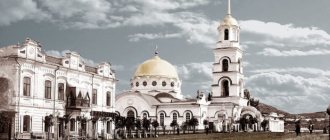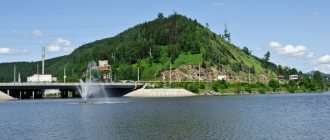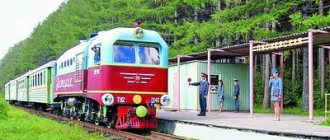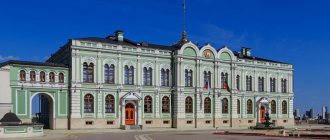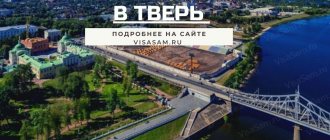History of appearance
Trekhgorny - (ZATO) in the Chelyabinsk region of Russia. Administrative center of the Trekhgorny urban district. The population is 32,355 people. (2017). It is located about 100 km from Zlatoust, near the city of Yuryuzan. The city is located on the Yuryuzan River.
In fact, due to its secrecy, there is very little information about the city. For a long time, due to the same reasons of secrecy, this city was not even put on the map and managed to change more than one name. First it was “Zlatoust-20”, then “Zlatoust-36”. And only after the veil of secrecy had lifted a little, on October 29, 1993, Zlatoust-36 was renamed Trekhgorny and included in the administrative-territorial division of the Chelyabinsk region.
But let's get back to history. The history of the city began on January 24, 1952, when the decision was made to build plant No. 933 for the production of atomic bombs. The construction site is a secret place near Chelyabinsk. And already on April 9, 1952 in the Vasilovka region, Yuryuzan, on the railway. The first echelon of construction workers arrived at the Krasnaya Gorka station. And on August 1, 1955, the plant began fulfilling the first government order. In August of the same year, two RDS-4 Tatyana tactical aviation atomic bombs were released.
Trekhgorny city
Trekhgorny , Zlatoust-20, Zlatoust-36 , city, center of the Trekhgorny urban district, closed city of federal subordination. Located in the western part of the Chelyabinsk region. (in the territory of the Katav-Ivanovsky district), 303 km from Chelyabinsk, on the river. Yuryuzani. The area of the closed city is 16.57 thousand hectares [including the residential zone occupies 897 hectares, mountains. forests (mainly parks) - 355 hectares].
Population 32,665 people. (in 1995 - 30.6 thousand). National composition: Russians (85.1%), Tatars (4.9%), Bashkirs (3.5%), Ukrainians (2.7%), etc. Population density. 201.03 people per 1 km2. In accordance with the Charter of the urban district of T., adopted in 2005, local self-government is carried out on its territory, will represent. the organ of which is mountains. collection dep. (president since 2005 S. M. Shaburov). Executive-manager. functions are carried out by the administration of T. (since 2005 it has been headed by N. I. Shimanovich). The official symbols of T.—the coat of arms and the flag—are included in the Heraldry. register of the Russian Federation (No. 1113 and 1320, respectively).
The coat of arms was approved by the post. mountains collection dep. No. 72 from December 5 2002. Developed by a group of artists and heraldists: V. P. Chertovikov (Trekhgorny), Yu. V. Korzhik (Voronezh), K. F. Mochenov, G. A. Tunik (Moscow). Description: “The shield is crossed by a lowered azure (blue, light blue) belt, thinly bordered with silver; above, in the azure, there are three green mountains with silver peaks; below - scarlet (red); on top of the belt there is a lowered golden one, about three orbits, the sign of an atom” (see color insert). Ch. the figure of the coat of arms - the sign of an atom with the orbits of electrons - symbolizes at. production as main industry branch T. Image. to the top parts of the mountain's coat of arms characterize the geogr. features of the city, surroundings mountain peaks (the name T. is connected with this). Coloring the green color of the mountain is an allegory of the riches of the surrounding nature, greatness, generosity, confidence, immutability, indestructibility. White color (silver) symbolizes simplicity, perfection, nobility, peace, cooperation; yellow (gold) - strength, strength, intelligence; blue - beauty, truth, honor, virtue; kr.—right, love, courage, bravery.
Flag approved by post. mountains collection dep. No. 58 from September 30 2003. It is a rectangular panel with a width ratio. etc. 2:3, on which the composition of the coat of arms is reproduced.
Nature . The terrain in which Trekhgorny is located is mountainous. A few kilometers to the southeast is the town of Zavyalikha, to the south-southwest is the town of Barkhotina, to the southwest is the Aksarka ridge, to the northeast is the Shuida ridge. The landscape is a subzone of spruce-fir forests with an admixture of pine, larch and foliage. breeds To the west of the city flows the Aksarsky stream, to the southeast - the Bakhtiarov stream (both are tributaries of the Yuryuzan).
Historical sketch . The history of the city is closely connected with the activities of the Instrument-Making Plant. Simultaneously with the construction of production facilities. objects began the construction of residential buildings for workers and employees of the institution, post office box No. 17 (the date of arrival of the first echelon of builders - April 9, 1952 - is considered the day of the foundation of T.). In accordance with the Decree of the Presidium of the Supreme. On March 17, 1954, the Council of the RSFSR established a workers' settlement (no name). By Decree of the Presidium of the Supreme. Council of the RSFSR dated October 28. 1955 the village was transformed into the city of Zlatoust-20 of district subordination; renamed in 1967 in Zlatoust-36 (February 16, 1968 received the status of a city of regional significance). According to post. Head of the Administration of the Chelyabinsk Region. from 29 Oct. 1993, in accordance with the law of the Russian Federation “On closed administrative-territorial formation” (dated July 14, 1992) and post. Presidium Top. Council of the Russian Federation “On establishing the subordination of ZATO” (dated May 31, 1993), the city of Zlatoust-36 became an administrative-territorial unit of Chel. region, received the status of ZATO and modern. name The borders of the ZATO were approved by the Decree of the President of the Russian Federation dated January 29. 1997. In 1995, the municipal municipality “Trekhgorny City” was created, which in 2005 received the status of an urban district.
Economy.
Currently, 643 business entities are registered in Trekhgorny, of which 436 operate in the field of material production, 120 are engaged in non-production. sphere. 58% of enterprises are privately owned, 9% are municipally owned, and 4% are federally owned. 6 number of largest enterprises in addition to Priborostroit. The plant includes: CJSC - "Aquapolymer" (production of high-tech consumer goods), "Promstroykabel" (manufacturing of cable and wire products), "RON-Telecom" (manufacturer of digital automatic telephone exchanges of large and medium capacity), "Forum" [ production of metal products and structures coated on the basis of polymer-powder materials (metal tiles), cast art. stone based on mechanical activation. cement], NPC "EcoMotor" (development of new generation engines; production of portable gas power plants), "UralAlmazInvest" (production of diamond products), "Promplita" (production of homogeneous particle board); OJSC - "Consul" (production of meat and dairy products), Trekhgornenskoye motor transport enterprise; LLC - "Tryokhgorny Ceramic Plant" (production of proppants of medium strength and zeolites), "Center for Environmental and Technogenic Monitoring" (creation of helicopter complexes with SAVR-M video thermal imaging equipment based on MI-8MTV, KA-32A helicopters). The Trekhgorny forestry enterprise also operates on the territory of the closed administrative unit.
Temples . In con. 1990s In one of the residential buildings of the city, at the request of residents, an Orthodox church was opened. Church in honor of the Intercession of the Blessed Virgin Mary. At the same time, the collection of donations for the construction of the temple began. 17 Oct 1999 On the site of the construction of the temple building, the ceremony of laying the first stone with the relics of St. Mitrofan. By 2004, the dome ceilings were installed, and interior construction began. finishing facilities. 29 Sep. 2005 the temple opened. Metropolitan Chel was present at the consecration ceremony. and Chrysostom. Job, rector-archpriest Fr. Paul. Job gave thanks. certificates for assistance in the construction of the temple to the head of the city Shimanovich, beginning. UKS B.P. Teslenko, regiment commander A.M. Sesitsky, head. builds. organizations that took part in the construction of the church.
Education . In 1953, the first school (now secondary school No. 106) and the first preschool were opened in Trekhgorny. institution; in 1954 - evening ShRM No. 107. In 1956 the city was organized. department of public education (first head: A. S. Zolotoreva), in 1962 - department of kindergartens. institutions (at the Instrument-Making Plant).
Currently, there are 15 kindergartens operating in the city. institutions, 7 general education. schools, 1 special (correctional) MOU - boarding school No. 111, prof. Lyceum No. 125, Trekhgorny Polytechnic. Institute - branch of MEPhI, representative office of SUSU. The additional education system includes: Children's Art School, Children's Creativity Center (CDT), Children's Ecological School. center, 2 youth sports schools, 2 sports schools. At school No. 106, the methodology of differentiation is being developed. training, within the framework of the cut along with general education. There are lyceum and specialized classes, as well as compensatory education classes (for children with developmental problems). Since 1993, an in-depth teaching program has been introduced. course of subjects in the humanities and physics and mathematics. cycles. In secondary school No. 109 (founded in 1962) there is a teacher-educator. the process is carried out within the framework of the program for the development of local innovations, which have received high expert assessment from Ph.D. ped. Sciences N.A. Edal and - Noah. Results of innovative activities of teachers. The school staff introduce themselves to the mountains. scientific-practical conf. and seminars. In secondary school No. 112 (founded in 1955), a deeper education was organized. studying mathematics; experiment created. platform for implementation in education. process of the 1st stage of TRIZ technology school. For many years, secondary school No. 112 has been the leader of the Olympiad movement among T. Ped schools. kindergarten teams. institutions operate under the programs “Childhood” (Preschool Educational Institution No. 4), “Gifted Child” and “Development” by L. A. Wenger (Preschool Educational Institution No. 2). Experiment. a program with elements of Montessori pedagogy (author L. R. Grebennikova) is being implemented by Preschool Educational Institution No. 18 “Montessori House”. In T. there are also compensatory preschool educational institutions; No. 7 (for children with disabilities in mental and physical development) and 13 (health improvement for children who are often and long-term ill). Prof. Lyceum No. 125 (PL-125) main. in 1984 as a PU for the purpose of training workers for SMU No. 6. First dir. was S.V. Rokutov. In 1997 the school was transformed into a lyceum. Provides follow-up training. specialties: auto mechanic, cashier controller, utility foreman, general construction foreman. works, master of finishing works, road-building driver. works, pastry chef, salesman, mechanical assembly mechanic, general machine operator. In school workshops produce door and window blocks, frames, and gardening tools. Volleyball and basketball teams PL-125 are regional winners. and region competitions. Since 2001, the Lyceum has been headed by V. I. Donchenko. The CDT was formed in 1993 on the basis of the House of Pioneers, the Club of Young Technicians and clubs at the place of residence at the housing department. Nowadays there are 48 groups, associations, circles, studios and creative arts in the CDT. laboratories, which are visited annually by approx. 2 thousand children and teenagers. In 1956, a children's music school was opened in T. (originally located in a barracks) with 3 departments: folk instruments, orchestral and php. In 1998, the institution was awarded the status of Children's Art School (director: Honored Worker of Culture of the Russian Federation S. Ya. Zabrodina). Now it has 7 departments (approx. 800 students): depict. art, folk instruments (accordion, balalaika, button accordion, guitar, domra), orchestral (cello, violin), theoretical, folk, php, choral. The school is located in modern 3-storey building with specialized classes, equipment audio and video equipment, with a music library, a music library, and 3 concert halls. DSHI - center. cultural life of the city: conducts concert and lecture work. enterprise teams and organizations, in schools, orphanages, etc. School reporting concerts, solo performances by students and teachers, and music have become traditional. productions (fairy tales and operas) for children, competitions for the best performance of music. prod. and others. Ans. folk instruments "Surprise" (including teachers from the Children's Art School) was awarded the title "Folk Collective" (2000). In 1979 in the village. A branch of the Children's Art School was opened in Dalny (now Trekhgorny-1).
Cultural life . K con. 1950s There was a builders club in the city (housed in a wooden barracks), a k/t, prof. b-ka. In 1967, the department of culture of T. was formed, the Crimea was headed by: V. P. Belov (1967-85), A. E. Arbuzov (1985-87), T. S. Kulagina (1987-89), Honored Worker of Culture of the Russian Federation L. N. Digileva (1989-2002). In 2002, the culture department of the city administration was transformed into the Department of Culture (first headed by O. A. Prokhorova, since 2006 - L. A. Aniskina).
Currently, it is in charge of: 2 public libraries (central city and central city children's), the Ikar cultural center, the Utes cinema, a museum and exhibition center [in 1975, Victory Square was laid out here , in which on June 22, 1986, the opening of the monument to military glory took place - a sculpture. composition depicting the goddess of victory Nike (author E. E. Golovnitskaya and L. N. Golovnitsky)]. Center. mountains The b-ka has been operating since 1956 (in its current status - since 1993). Dir. hers were: V.K. Sokolova (1956-81), T.D. Rubanova (1981-86), E.P. Levashkina (1986-88); since 1988 - Z. I. Kashirina. The universal book fund contains 140 thousand volumes. Approx. serviced annually. 14 thousand readers; carried out approx. 300 mass events, attended by 7 thousand residents. cities. There are interest clubs “In the Circle of Friends” and “Gardener”. Center. mountains the children's library was organized in 1957. Director: V. L. Grekova (1957), S. A. Boyarintseva (1957-78), Digileva (1978-89), Aniskina (1989-2006); since 2006 - I. V. Pervukhina. The library's universal collection contains 93 thousand volumes. 12 thousand young readers are served annually; More than 1 thousand mass events are held, which are attended by approx. 19 thousand people The traditional holiday programs “Leave everything and read!” and the theater of book performances “Open Book” (participants in the performances are children and teenagers aged 6 to 17 years) are very popular among children. In 2001 the theater took part in the region. festival “Bibliostart in the 21st century” and took 1st place in the “Theatre of the Book” nomination. The Ikar House of Culture opened in 1971. Director: Honored Worker of Culture of the Russian Federation D. A. Dynin (1971-99), B. L. Loza (1999-2002), S. Yu. Karelin (2002-03); since 2003 - N. L. Tyrlova. The team is implementing a long-term program “Development of folk art and cultural and leisure activities.” The title of “People's Collective” was awarded to: the vocal group “Reefs” (director E. Khurtin), husband. vocal group “Russians” (M. P. Zaets), academician. choir (V. Laevskaya), circus group “Grotesque” (N. Smolnikova), choreography. ans. “Lyubava” (N. Yurischeva), ballroom dance ensemble “Lada” (S. Rusakova), folk orchestra (Z. Karelina), pop orchestra (A. Andreev). Mn. art groups. amateur performances are participants in the All-Russian, regional, regional. folk festivals creativity, held in the Chelyabinsk region, Orenburg, Penza. The IEC was created on the basis of the mountains. museum in 1998. Exhibition area 650 m2. A concept for the development of the International Exhibition Center as a spiritual and historical center has been developed. heritage. The fund contains approx. 30.5 thousand exhibits, including collections of coins and currency. signs of the USSR; badges “History of the Chelyabinsk Region”, “History of the Instrument-Making Plant”; postcards, miniature books, Kasli castings. In 2006, the IEC received the status of art history. museum. Every year, events are held in T.: the “Stars of the 21st Century” festival, New Year and Christmas concerts, and theatrical performances. performances, dedication Defender of the Fatherland Day, Int. wives day, Victory Day, Children's Day, Russian Independence Day, etc., adv. festivities “Maslenitsa”, “Russian Birch”; City Days; theatricality. holidays; mountains alumni ball "June Dawns". The striking events in the cultural life of the city in the last 10 years have been the zones. festival-competition of choral singing “Spring Voices” (1989), interregional. CATO vocal competitions (1991, 1993), interregional. festivals “Stars of the XXI Century” (1995, 2000), Interregion. pop dance festival-competition. and circus groups “Lights of the Footlights” (1996), Days of Culture of T. in Chel. (1999). There is an association of amateurs in the city. poets and prose writers "Istok" (since 1969), as well as creative. association of artists "Rainbow" (since 1967). The city's media include television and radio, gas. “Spectrum”, “Sports version”, “Teleport”.
Healthcare . First honey. Trekhgorny's institution was a hospital, established in 1952. Beginning. his name was M. A. Morozova. In 1953, by order of the Ministry of Health of the 3rd Main Directorate, medical unit No. 72 was organized (headed by A.I. Morozov), located in a barracks-type building. The clinic was attended by 7 specialist doctors; There was an emergency medical service. In 1954, a paramedic station, a state center, began operating. San.-epidemiological supervision. In 1956 the mountains were put into operation. a polyclinic (for 250 visits per shift) and a 3-story hospital (for 150 beds), which included therapeutic, surgical, gynecological, maternity, children's departments, a pharmacy, and an emergency medical service. Later, a maternity hospital (1966), a children's clinic and a hospital with 60 beds (1967), a sanatorium with 100 beds (1970), Ch. Sanitary-epidemiological building station (1973), pharmacy (1981), 7-story surgical building. body (1981). On the basis of Medical Unit No. 72, intern doctors were trained in basic. specialties: pediatrics, dentistry, therapy, surgery. Since 1994, cooperation with honey has developed. institutions in Germany. Anesthetic drugs were purchased. equipment, endoscopic equipment for minimally invasive surgical procedures. surgeries, ultrasound scanner. In con. 1990s - early 2000s the building of the infectious diseases department and a dairy kitchen were built, and the buildings of the children's department of the hospital were reconstructed. In 2000, a region was organized on the basis of Medical Unit No. 72. diagnostic center, in 2002 - bureau of forensic medicine. examination, in the children's clinic - the department will be restored. treatment.
Currently, Medical Unit No. 72 is a multidisciplinary treatment and diagnostic unit. institution, which includes a hospital (12 departments), city. and children's clinics, treatment and diagnostic. departments (departments of radiation diagnostics, pathology, ambulance and emergency medical care, physiotherapy, etc.; endoscopic rooms, functional diagnostics). Outpatient clinics medical services are provided. assistance to the adult population in 28 medical specialties. Honey is sold. programs: “Combating drug addiction and substance abuse”, “Motherhood and childhood”, “Prevention of dental caries and periodontal diseases in children and adolescents”, “Improving the quality of life of patients with bronchial asthma; 8 anti-epidemic programs. The medical unit is equipped with modern equipment; here are the traces. honey. services: computed and magnetic resonance imaging, lithotripsy, X-ray and ultrasound diagnostics, fibrogastro-, colon- and bronchoscopy. The children's clinic has created health passports for each child; will be restored in the department. treatment rooms include massage, mechanotherapy, psycho-emotional therapy. unloading, cardiopulmonary, vision correction, etc., gyms and treatment. physical education; hydrotherapy is carried out (bass, hydromassage, balneological baths). Six honey employees of Medical Unit No. 72 were awarded the title of honored. Doctor of the RSFSR, 1 - Honored Health Worker of the Russian Federation. Beginning Medical unit No. 72 in different years: I. D. Kurnosov (since 1957), Yu. A. Zamyatin (since 1965), V. I. Bolotov (since 1988), V. Yu. Zinin (since 2002), G. K Bezrodny (since 2003).
Sport life . Simultaneously With the construction of the plant and the village, physical education developed. movement. First it builds. divisions, since 1954 - teams and sections for team sports (volleyball, basketball, football), as well as skiing, chess, track and field and weightlifting, and boxing were created in the plant management. Due to lack of equipment. sport. training areas and competitions took place in open areas near barracks and dormitories. In 1954, the Stroitel stadium was built (later renamed to Khimik). At the origins of physical education. movements in T. were: I. N. Antonenko, M. Baranov, V. V. Belousov, A. K. Deryushev, V. M. Dyachenko, V. D. Kozlov, V. N. Lopatkin, A. M. Melnikov and others. In December. 1954 meeting took place. mountains physical education asset, where the council of the physical education team was elected (the first chairman was Deryushev). Founded in 1958 city sports council; pres. his were: A. N. Golubev (1958-63), A. P. Marfitsin (1964-78), G. G. Melchakov (1978-93). With the support of the city government, children and young people developed in T. sport; massive mountains were held. sport. action; pl. attention was paid to the participation of residents. in the region, republic, all-union, international. competitions, sports development. infrastructure. In 1955 the 1st athletics competition took place. relay race. In the 1960s-80s. events were held regularly. for passing GTO standards, technical competitions. types of sports. The sports complex of the Trud stadium (1960-61), the Sports Palace with swimming pools were put into operation. bass (1967), sports complex Children's and Youth Sports School No. 1 (1979) with specialization. acrobatics and athletics halls, a football field, and a running track. In 1993 Council of Physical Education and Sports renamed. at the MU "Physical Education and Sports" ("FiS"; first director: Antonenko, then - V.F. Galiev; since 2003 - A.B. Novikov). 17 sports are cultivated at FiS: athletics, aerobics, basketball, tennis, volleyball, water tourism, alpine skiing, athletics, cross-country skiing, motocross, table tennis, paragliding, snowboarding, sports. bridge, football, hockey, chess. There is a stadium, a swimming pool, a ski lodge, a shooting range, basketball, volleyball, hockey courts, etc. A ski resort opened in 2000. Among traditional sports. measure T.: cross-country skiing for the prize of the first dir. instrument maker. plant K. A. Volodin (held since 1971), athletics. relay race (annually on May 9), volleyball tournament in honor of Police Day, tournament in memory of V. Mironov, all-Russian. judo competitions (for the prize of V. Prohoch, A. Misyagin); Boxing tournaments among juniors, mountains. Spartakiads labor. teams, military units, defense industry workers and the Ministry of Internal Affairs; mini-football competition for the prize gas. "Sports version"; complex sports and athletics competition of CATO (leading athletes of the country take part in it). The first masters of sports in T. were: Antonenko (skiing, 1964), A. Zaitsev (weightlifting, 1964), A. Mangaev (speed skating), and others. Among the titles. athletes: master of sports, international bronze medalist. race “Finlandia hiihto” (Lahti, Finland; 2000) I. Dekhanov; master of sports, international medalist half marathons (France, England, Greece), champion and prize-winner. region in athletics M. Zobov; master of sports, champion of Russia in motocross in the 250 cm3 class (2001-02) A. Safronov; bronze medalist of the Russian Championship (2002), winner of the Russian Cup, winner of the World Cup (St. Petersburg) in polyathlon A. Khavanov. The hockey team “SkiK” (coach N. E. Rozhkov) is a participant in the Russian championship in class “A” of the 2nd league, champion of Ural-Sib. region (in the 2001/02 season). The football team is the winner of the Chel championship. region (1976, 2000), winner of the regional cup (1999), participant of the Russian Championship of the 3rd division. Women The basketball team is the champion. T. coaching staff (1960-80s): V.K. Grigoriev (football); M. M. Davydenko, R. A. Kirikovskaya, I. N. Kirikovsky (athletics); V. V. Kachalov (swimming); V. M. Korobkin, T. I. Makriy (skiing); Melchakov (sports gymnastics); A. E. Popov (boxing); I. K. Serebryakov (speed skating). There are 4 sports in the city. schools. SDYUSSHOR No. 1 main. in 1967 as SDYUSHOR (since 2001 it received specialized status); departments are open: acrobatics, athletics, acrobatic jumping. track, football. Coaching staff: excellent student of public education of the Russian Federation Davydenko, honored teacher of the Russian Federation Kirikovskaya, international judge. category A. Yu. Suleeva and others. Among the students: winner of the Russian championship in acrobatic jumping. path D. Gorshenin; master of sports, winner of the Russian championship in acrobatic jumping. path R. Kobelev; multiple winner of the Russian Athletics Championship A. Reunkov. Children's and Youth Sports School No. 2 main. in 1962; There are basketball, volleyball, skiing, swimming, and hockey departments. Coaching staff: excellent students of physical culture of the Russian Federation Kachalov, V.F. Dobroskok, honor. worker of general education of the Russian Federation V.P. Korotkov and others. Among the students: prize-winners of the championship. region in volleyball E. Burkina, A. Kholyaeva; winner of the regional cross-country skiing championship, participant of the Russian championship A. Baryshnikova. SDYUSSHOR in judo basic. in 1995; There are judo and karate departments. Among the trainers is the Honored Worker of Physical Culture of the Russian Federation V.V. Zaitsev. Among the students: winner of the international. judo tournament S. Gusev; 2-time international winner judo tournament, bronze medalist of the World Youth Cup (Hungary, 1998) A. Tsivilev; champion of Russia (1993), silver medalist of the World Universiade (Japan, 1995), member. Russian national team (1993-96) A. Misyagin; silver medalist of the Russian Championship (1993), European Team Championship (1994) A. Ignatenko; winner of the Russian Championship among juniors, international. tournaments category “A” (Italy, Bulgaria) S. Zakalyapin. The sport was created in 1997. "Judo" club, providing logistical and technical support. help to school. SDYUSSHOR in boxing main. in 1998. Among the students there is an international silver medalist. tournament in Poland, bronze medalist of the World Cup in Astana (Republic of Kazakhstan), medalist of the Russian Cup (2000), winner of the Russian Cup (2001), medalist of the international. tournament in Turkey, winner of the Russian Boxing Championship (2000), winner of the international. tournament in Yugoslavia (2002), international master of sports. class (2002) M. Khalikov; winner of the Russian championship among federal districts in Chelyabinsk, winner of the Russian Cup (1997), silver medalist of the Russian championships (1997-99), winner of the international. tournaments in Denmark, Poland, Croatia, international master of sports. class (1999) A. Astrakhantsev.
map [0 54.817842 58.446423 13 0]
Current state
As I said above, only after the veil of general secrecy was lifted a little on October 29, 1993, Zlatoust-36 began to appear on maps, but already under the name Trekhgorny, as you might guess - due to its geographical location, between three mountains. But despite this, the veil of secrecy never ceases to haunt him.
Even today the city remains closed; it is almost impossible for an ordinary person to get into it if he does not have relatives in Trekhgorny. The city is surrounded by three rows of energized thorns and a trace strip. Traffic along the adjacent highway is strictly non-stop; there are two stationary traffic police posts at a distance of 500 m.
According to official information, the main enterprise of the CATO is the Instrument-Making Plant (engaged in the production of nuclear weapons). But to what extent this is true is difficult to say. After all, there are even more unofficial theories: local residents can talk about underground factories that produce secret products, special storage facilities for nuclear weapons and other particularly important facilities.
Now on Google maps you can see every checkpoint and see the factory pipes in detail, but everything else is under careful guard and classified as “top secret.” Are the residents' stories true or are they nothing more than speculation and rumors? Alas, we most likely will not know this for sure.
In the end, I’ll just add that in 2011, five Novouralsk cyclists decided to make an unusual trip to four Ural closed administrative towns, including Trekhgorny. If you are interested in seeing a selection of photos from their hike, come here.

